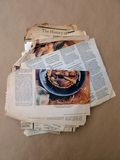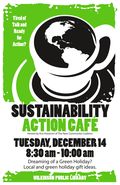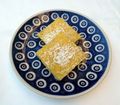Myco-Solstice
by Art Goodtimes pulsing flicker ofmountain shroom shadowscircling as embers abovewatching starslike petri dishes ofexpanding mycelial thought ...
by Art Goodtimes pulsing flicker ofmountain shroom shadowscircling as embers abovewatching starslike petri dishes ofexpanding mycelial thought ...
December 9, 2010 We are so pleased to participate in the Telluride Inside Blog. Check this section of the Blog -- entitled Telluride Institute News – every second Thursday for updates concerning all Institute events and programming. Last year, The Telluride Institute celebrated 25...
by Lisa Barlow
 You don’t have to be a New Yorker to have accumulated a thick file of favorite recipes clipped from The New York Times over the years. My grandmother, who lived in Texas, kept tear sheets with recipes from the Sunday New York Times Magazine tucked into the cookbooks in her kitchen.
You don’t have to be a New Yorker to have accumulated a thick file of favorite recipes clipped from The New York Times over the years. My grandmother, who lived in Texas, kept tear sheets with recipes from the Sunday New York Times Magazine tucked into the cookbooks in her kitchen.
If the New York Times motto is “All the News that’s Fit to Print”, you could say that I was raised on “All the Food that’s Fit to Eat”. My mother, an avid cook, eagerly followed every recipe written by Craig Claiborne, the paper’s inspired food columnist during the years I was growing up. She kept her recipes for the hearty stroganoffs, ratatouilles, pistous, and even the sad soy burger, an outlier among the richly flavored favorites, in a drawer next to the grocery money in the kitchen.
In her new magnificent compendium, The Essential New York Times Cook Book, Classic Recipes for a New Century, Amanda Hesser, a longtime food writer and staff member at the Times, gives new life to many of the fragile yellowing scraps of paper in my own file. Not only have I reconnected with the staples of my childhood: the David Eyre pancake and Welsh Rarebit, she has introduced me to the intriguingly named “Epigram of Lamb”, which first ran in the paper in 1879, and to the myriad delights of recent recipes published while I wasn’t paying attention.
by Walter Wright
 Kristin Holstrom, coordinator of The New Community Coalition, hosts a Sustainable Action Cafe at Telluride's five-star Wilkinson Public Library. The first gathering in a series takes place Tuesday, December 14, 8:30 – 10 a.m. We created these informal get-togethers with you in mind if you are tired of talk and want to see some action.
Kristin Holstrom, coordinator of The New Community Coalition, hosts a Sustainable Action Cafe at Telluride's five-star Wilkinson Public Library. The first gathering in a series takes place Tuesday, December 14, 8:30 – 10 a.m. We created these informal get-togethers with you in mind if you are tired of talk and want to see some action.
This month’s "action: targets ways to green up the holidays. It goes without saying we in Telluride all hope for a very white winter and pray for more snow. But green and white are not a bad combination.
At this Sustainable Action Cafe, Kris plans to open up the discussion to include local and green holiday gift ideas, and tips for saving money. Do we have to buy to be happy? If we don’t buy how do businesses survive? What does a thriving, sustainable community look like during the holidays and after? Other thoughts? Please bring them with you on Tuesday.
by Eliot Brown; photos by Mary Sama-Brown
Part 2, "Park City to Yellowstone"
(Ed. note: The first installment of the Browns' road trip was published on Telluride Inside... and Out on November 22)
 At 8:30 AM, Monday we put Park City in the rear view mirror and headed out on Interstate 80 toward Evanston, WY, and then North on US 89 along the Idaho/Wyoming boarder toward Jackson Hole for Grant Village in Yellowstone National Park. The 6 3/4 hour drive past huge windmill power farms, huge ranches, beautiful prairies and valleys with little or no traffic allowed the 911 to strut her stuff. My wife Mary only had to close her eyes a couple of times as I enjoyed the open road, albeit, sometimes a bit aggressively.
At 8:30 AM, Monday we put Park City in the rear view mirror and headed out on Interstate 80 toward Evanston, WY, and then North on US 89 along the Idaho/Wyoming boarder toward Jackson Hole for Grant Village in Yellowstone National Park. The 6 3/4 hour drive past huge windmill power farms, huge ranches, beautiful prairies and valleys with little or no traffic allowed the 911 to strut her stuff. My wife Mary only had to close her eyes a couple of times as I enjoyed the open road, albeit, sometimes a bit aggressively.
It is only fitting that I insert a little Yellowstone history here to pay tribute to our first national park. Near the headwaters of the Yellowstone River, an area home to the Shoshone Tribe, John Colter, in the early 1800s described what was mocked as Colter’s Hell, a place where mud boiled and steam rose from the ground.
Come on, you know you wanna! Don’t you want to be able to make coffee mugs, ice cream bowls? They make great gifts and trust me, people LOVE them. Well, our very own Goedele Vanhille will be teaching Beginning Wheel Throwing next weekend...
by Tracy Shaffer
Cool morning, bright day. I sit down for tea with artist, Riva Sweetrocket, in her gorgeous Ballpark Neighborhood loft. She meets me at the door and takes me into her studio, a clean and spare space which reflects the clarity of her thought and vision. A 44 x 38 inch paper is affixed to a Plexiglas wall; the striking image of a crimson cushion with an oversized, gold satin bow hovering above it is in progress. There is nothing else in the room but light, a small cart holding art supplies and a larger blank sheet of paper on another wall, awaiting inspiration.
The precision of Sweetrocket’s work is extraordinary. Many times I’ve stood before her works at Denver’s Plus+ Gallery, mesmerized and wondering “How does she do that?” It was my privilege to find out. We spoke of images, what strikes the eye and how these fascinations reach the gallery wall. “I keep a file of photographs, things I see and the colors and textures I find appealing. Most of the time I photograph them myself, but others come from memory. When I get an idea about what I want to put together, it all comes alive in Photoshop” says she. I get a sense that there is a lot of silence and rumination in this woman’s daily life, and a fair amount of chalk dust. Riva’s works are created in soft pastel on paper and have a luxuriant quality that is radiantly defiant of the medium. “Once I’m happy with the image, I begin the work on paper and that is when it starts to really come alive” she continues.
 The Velvet Ribbon exchange is an original fundraising idea, a chance to give to the Sheridan Arts Foundation, at the same time receive something fabulous for yourself in return. Quid pro quo in action.
The Velvet Ribbon exchange is an original fundraising idea, a chance to give to the Sheridan Arts Foundation, at the same time receive something fabulous for yourself in return. Quid pro quo in action.
Throughout the month of December, the lobby of the Opera House doubles for the inside of a gift store, white gift boxes tied with red velvet ribbons throughout. The boxes, numbered 1 – 50, are all on sale for $250, but the individual contents are a secret until the donor opens the box associated with the number he picks.
Prizes range in value from $100 – $8,000+, but the majority of items are valued over $100. In addition to his prize, each purchaser receives a $150 tax deduction letter for the donation made to the Sheridan Arts Foundation, a 501(C)(3) nonprofit.
by Lisa Barlow
 The Meyer lemons sitting on my kitchen table are like a bowl of sunshine. Rounder and deeper in color than regular lemons, they are also harder to come by, unless you live in Southern California and are blessed with a prolific tree in your back yard. From November through January, when the lemons migrate to fruit aisles in specialty markets outside of California, you want to grab them. Don’t look at the price tag, just inhale their sweet scent and be grateful for a lucky score.
The Meyer lemons sitting on my kitchen table are like a bowl of sunshine. Rounder and deeper in color than regular lemons, they are also harder to come by, unless you live in Southern California and are blessed with a prolific tree in your back yard. From November through January, when the lemons migrate to fruit aisles in specialty markets outside of California, you want to grab them. Don’t look at the price tag, just inhale their sweet scent and be grateful for a lucky score.
As a native New Yorker, the unique pleasures of the Meyer lemon are not imprinted on me. But for many a transplanted West Coaster, they serve as powerful triggers for sense memories, able to transport one back to childhood or into an old love affair.
Yet another installment of Telluride locals David Byars and Jenny Jacobi sub-Saharan philanthropy adventure. This week, they're going underground to explore a Ghanaian phenomenon, galamsey mining. Join them here....